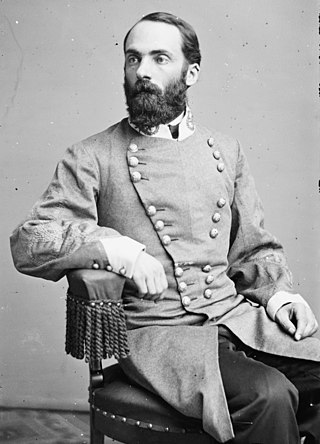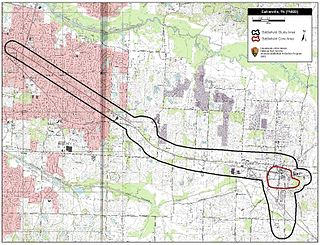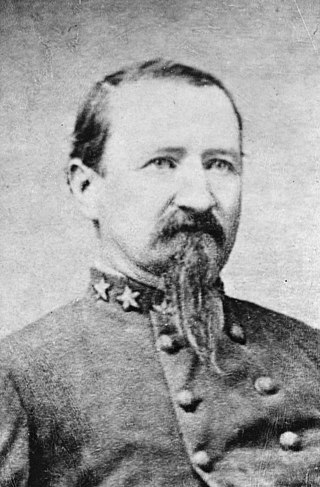
Joseph "Fighting Joe" Wheeler was a military commander and politician of the Confederate States of America. He was a cavalry general in the Confederate States Army in the 1860s during the American Civil War, and then a general in the United States Army during both the Spanish-American and Philippine–American Wars near the turn of the twentieth century. For much of the Civil War, he was the senior cavalry general in the Army of Tennessee and fought in most of its battles in the Western Theater.

The Second Battle of Collierville, also known as the Action at Collierville, was fought during the American Civil War between the United States (Union) and Confederate States. The fighting occurred during a demonstration on Collierville, Tennessee, by Brigadier-General James R. Chalmers, Confederate States Army.
The Battle of Dover, also known as the Second Battle of Fort Donelson, was a battle of the American Civil War, occurring on February 3, 1863, in Stewart County, Tennessee.

The Knoxville campaign was a series of American Civil War battles and maneuvers in East Tennessee, United States, during the fall of 1863, designed to secure control of the city of Knoxville and with it the railroad that linked the Confederacy east and west, and position the First Corps under Lt. Gen. James Longstreet for return to the Army of Northern Virginia. Union Army forces under Maj. Gen. Ambrose Burnside occupied Knoxville, Tennessee, and Confederate States Army forces under Longstreet were detached from Gen. Braxton Bragg's Army of Tennessee at Chattanooga to prevent Burnside's reinforcement of the besieged Federal forces there. Ultimately, Longstreet's Siege of Knoxville ended when Union Maj. Gen. William Tecumseh Sherman led elements of the Army of the Tennessee and other troops to Burnside's relief after Union troops had broken the Confederate siege of Chattanooga. Although Longstreet was one of Gen. Robert E. Lee's best corps commanders in the East in the Army of Northern Virginia, he was unsuccessful in his attempt to penetrate the Knoxville defenses and take the city.

The 1st Alabama Cavalry Regiment served in the Confederate Army during the American Civil War.

Wheeler's October 1863 Raid was a large cavalry raid in southeastern Tennessee during the American Civil War. Maj. Gen. Joseph Wheeler's Confederate cavalry scored a great initial success, but subsequently was roughed up by Union cavalry during its withdrawal south of the Tennessee River.
The 5th Ohio Cavalry Regiment was a regiment of Union cavalry raised in seven counties in southwestern Ohio for service during the American Civil War. It primarily served in the Western Theater in several major campaigns of the Army of the Tennessee.

Mark Perrin Lowrey was a Southern Baptist preacher otherwise known as the "Preacher General". He is known for being a Confederate brigadier general during the Civil War, for his works in the Mississippi Southern Baptist Convention, and for founding Blue Mountain College.

William Young Conn Humes was an American educator, lawyer, and soldier. He served as a Confederate cavalry general during the American Civil War, in which he was wounded twice, and fought mainly in the Western Theater of the conflict. Afterward Humes resumed practicing law until his death.
The 3d Arkansas Cavalry Regiment (1861–1865) was a Confederate Army Cavalry regiment during the American Civil War.

James Hagan was a United States Army captain during the Mexican–American War and a Confederate States Army colonel during the American Civil War. He was also a prosperous businessman and planter in Mobile, Alabama between both conflicts.

Charles Constantine Crews was an attorney, physician, railroad executive and Confederate Colonel in the American Civil War. Between 1862 and 1865, he participated in most of the Western Theater cavalry campaigns of Major General Joseph Wheeler, initially leading the 2nd Georgia Cavalry and eventually a cavalry brigade.

Farmington is an unincorporated community in Marshall County, in the U.S. state of Tennessee. The community is concentrated around the intersection of U.S. Route 31 and State Route 64 west of Shelbyville and east of Lewisburg.

Confederate Cemetery Monument is a monument that includes a cemetery for veterans of the Confederate States Army during the American Civil War, especially the Battle of Farmington under General Joseph Wheeler, in Farmington, Tennessee, U.S. It includes four walls around the cemetery and a "pyramid-topped obelisk". A historical marker on reads "In the cemetery north of the road are buried Confederate soldiers of the Army of Tennessee, who fell while opposing Rosecrans' Army of the Cumberland through Liberty Gap and Guy's Gap, in late June 1863. Also buried here are soldiers of Forrest's Cavalry, killed in minor operations.". It has been listed on the National Register of Historic Places since July 11, 2001.
The 19th Louisiana Infantry Regiment was an infantry regiment from Louisiana that served in the Confederate States Army during the American Civil War.
The 4th Missouri Infantry Regiment was formed on April 28, 1862, and served in the Confederate States Army during the American Civil War. The infantry regiment did not see action at the Battle of Farmington on May 9, and the Battle of Iuka on September 19 despite being part of the Confederate force present at those battles. As part of Brigadier General Martin E. Green's brigade, the regiment participated in three charges against Union lines on October 3, 1862, during the Second Battle of Corinth. The following day, the regiment, along with the rest of Green's brigade, attacked the new Union lines. Despite initial success, the attack was repulsed by a Union counterattack. The regiment ceased to exist as a separate unit when it was combined with the 1st Missouri Infantry Regiment on November 7, 1862, to form the 1st and 4th Missouri Infantry Regiment (Consolidated).

On September 6, 1863, near Little Rock, Arkansas, a duel was fought between John S. Marmaduke and Lucius M. Walker, two generals in the Confederate States Army. Tension had risen between the two officers during the Battle of Helena on July 4, 1863, when Marmaduke accused Walker of not supporting his force, and then retaliated by not informing Walker of a Confederate retreat. Marmaduke was later assigned to serve under Walker during a Union advance against Little Rock. Walker did not support Marmaduke during a retreat after the Battle of Brownsville, and Marmaduke questioned Walker's courage after the Battle of Bayou Meto on August 27. A series of notes passed between the two generals by friends resulted in a duel, during which Marmaduke fatally wounded Walker. Marmaduke was arrested and charged with murder but was soon released, and later the charge was dropped. He survived the war and later became Governor of Missouri. Union forces captured Little Rock later in the campaign, after the Battle of Bayou Fourche.

The 20th Louisiana Infantry Regiment was a unit of volunteers recruited in Louisiana that fought in the Confederate States Army during the American Civil War. The unit began its existence as the 6th Louisiana Battalion in September 1861. The battalion was augmented to regimental strength in January 1862 at New Orleans and served during the war in the Western Theater of the American Civil War. The regiment fought at Shiloh, Farmington, and Perryville in 1862. After being reduced in numbers, the regiment was consolidated with the 13th Louisiana Infantry Regiment and served at Stones River, Jackson, Chickamauga, and Missionary Ridge in 1863. The 13th-20th Consolidated Louisiana fought at Resaca, New Hope Church, Ezra Church, and Nashville in 1864. The consolidation with the 13th Louisiana was discontinued in February 1865 and the regiment was re-consolidated with other units. It fought its final battle at Spanish Fort one month before surrendering in May 1865.

George Washington Roberts was an American soldier who served as colonel and commanding officer of a Union Army brigade in the Army of the Cumberland during the American Civil War. Roberts was killed in action leading his troops to repel Confederate attacks at the Battle of Stones River in 1862.













